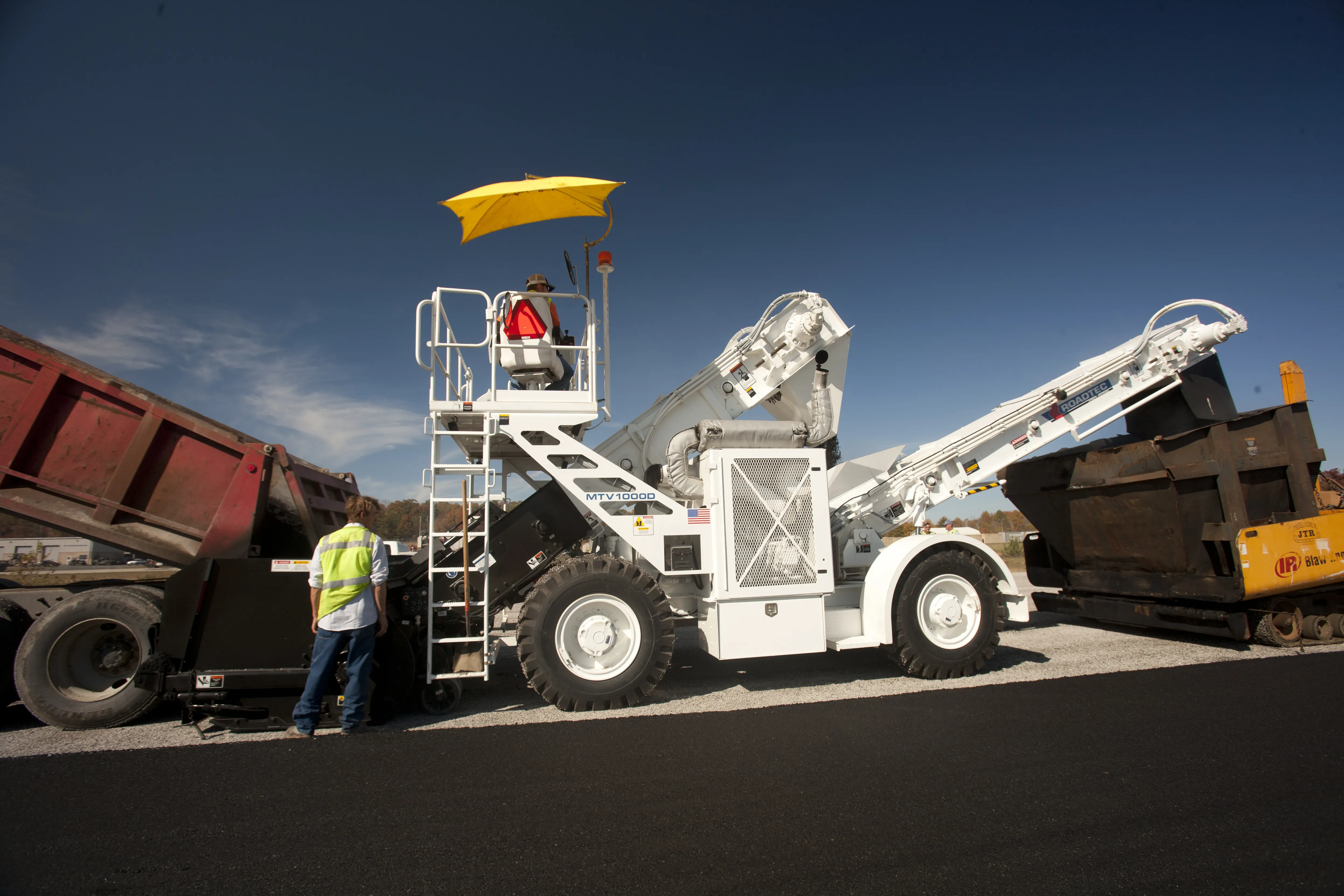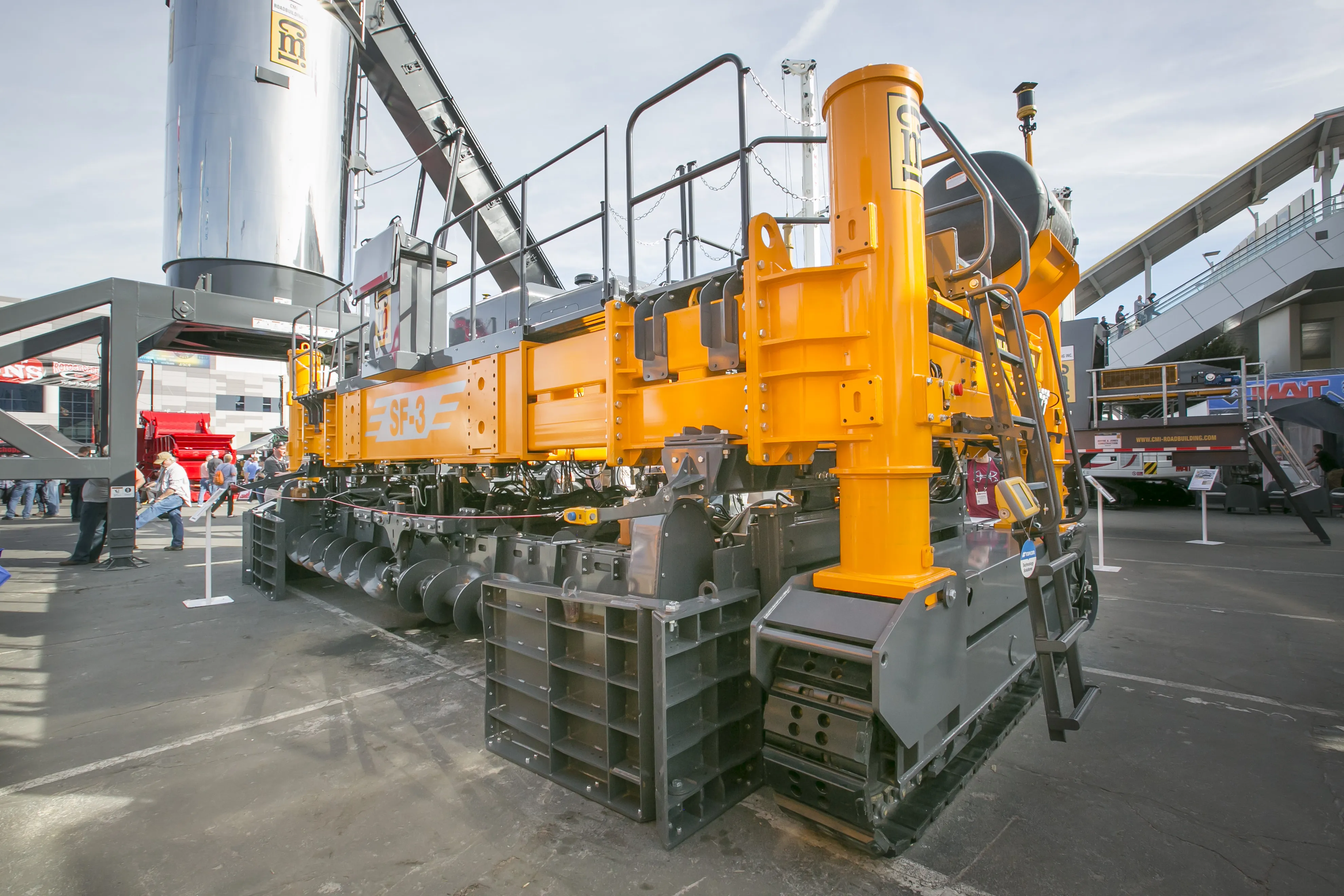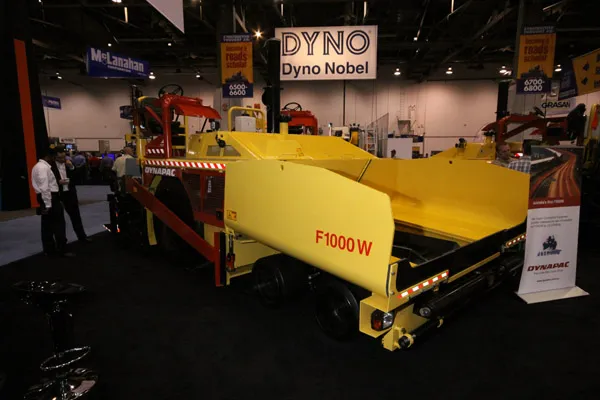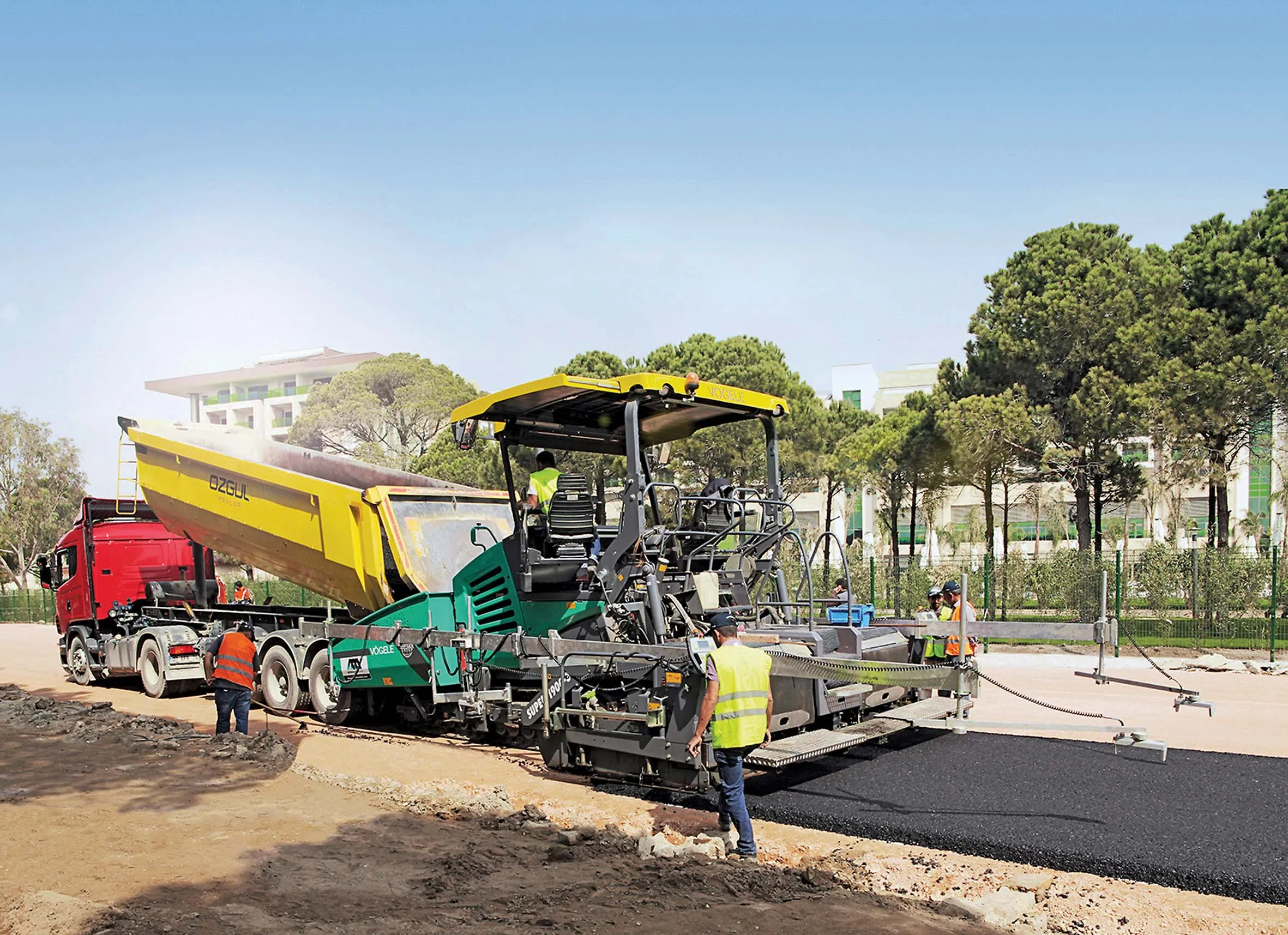A growing niche market for roller compacted concrete has prompted manufacturers to offer solutions. Mike Woof reports. Increased demand for roller compacted concrete (RCC) machines in certain applications mean that this is now a growing market, with manufacturers having developed new machines for this sector. RCC comprises uncrushed and/or crushed aggregate, hydraulic binders and may also contain concrete additives. It is mixed in a concrete mixing plant on or near the job site and one of its main benefits
February 20, 2012
Read time: 6 mins
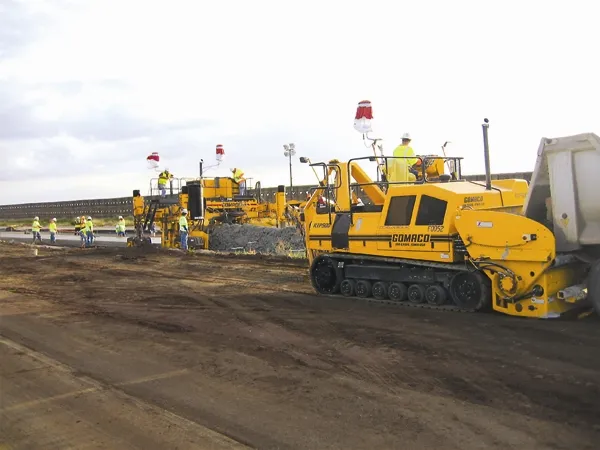
RSS1074 RCC) machines in certain applications mean that this is now a growing market, with manufacturers having developed new machines for this sector. RCC comprises uncrushed and/or crushed aggregate, hydraulic binders and may also contain concrete additives. It is mixed in a concrete mixing plant on or near the job site and one of its main benefits is that it takes significantly less time to cure than conventional concrete. As a result it can carry traffic shortly after being laid and also gives good structural integrity. The mix is transported by conventional feed vehicles and transferred to a paver, with the concrete layer then being compacted with rollers.
The paving method has been used for some years but technical developments in recent times have broadened its range of applications and steadily widened its use. This approach has been used successfully for some time in large open areas such as logistics facilities to provide a surface that can carry high load capacities without rutting or other fatigue issues. The more recent development mean that this technology is also being used in residential and city streets, pedestrian walkways, intersections and interstate ramps.
Some contractors run modified asphalt pavers in this application and at the recent CONEXPO-CON/AGG event in Las Vegas,1194 Vögele said that its Super 2100-2 has been used by a number of customers for this type of work. Marketing manager Roland Schug said, "Contractors find it useful for RCC paving. You can get 305mm lifts and high compaction density." He added that because of the tamper system in the screed, this allows the machine to deliver a high density finish.
According to Vögele, the moisture content of RCC is crucial for achieving maximum precompaction values. If the material contains too little water, efficient compaction may prove, while if it contains too much water, the screed could sink into the mix. As a result, the moisture content should be checked carefully and tests of the mix should be carried out at the site. RCC is stiff enough to be compacted with vibratory rollers, however, the number of roller passes must be kept to a minimum in order to deliver stability, evenness and surface structure.
Asphalt pavers from many major manufacturers can be used in an RCC application, not just those from Vögele. However, the nature of an RCC job is tough on an asphalt paver as concrete is typically more abrasive than asphalt and for this reason218 Gomaco opted to develop its own unit that is designed for harsh, zero-slump mixes. GOMACO developed the machine to provide customers with a further paving option and this model is now proving itself on-site with contractors. At present the machine is offered in the US market only, where the demand for RCC paving is growing in states such as Ohio and Minnesota, and is not available internationally.
Based on the firm's tracked RTP-500 placer, this machine is equipped with a screed that is purpose-built with extra wear resistant plating in key areas to cope with the abrasive concrete. The plates extend the working life of the screed in RCC operations and can be removed and replaced quickly, to minimise downtime. The screed can handle variable slab depths and telescopes from 3.05-5.89m to suit a variety of paving jobs, while the dual tamper bar system telescopes to the same widths and ensures uniformity of density and strength. Dual augers with diameters of 356mm supply material across the screed and these are independently driven to ensure effective operation. The screed features hydraulic crown adjustment as well as variable hydraulic control of its vibration system. Other screed features include minimum side-clearance requirements and removable covers and a front strike-off wall to allow easy maintenance.
The RTP-500 runs on twin rubbers tracks that provide high job-site mobility and has a hopper with a capacity of 3.63m3, as well as a high-speed transfer conveyor with increased throat clearance. The auger-style receiving hopper is 3.28m wide and can handle high-volume, end-dump paving operations. It has 305mm of vertical adjustment to allow for gate height on dump trucks and a 356mm diameter auger to move the material to the transfer conveyor. Shaft-mounted eccentric vibrators aid in emptying of the hopper after each load and increase material flow, while a hydraulically tensioned cable provides consistent sealing for a wide variety of dump truck bodies. The conveyor helps boost productivity as it is 10.67m long and 914mm wide, with 170° hydraulic swing, and offers 3.66m of vertical adjustment. This unit allows for fast and accurate material placement from the haul road, over the stringline or other obstacles, while a deflector directs the flow of concrete at the discharge end of the conveyor. Hydraulically folding, the rear conveyor reduces the shipping length to 11.35m and the machine has a width of 3.59m with the hopper attached, 3.15m without the hopper, and a height of 3.56m with its conveyor folded. Power for the proven placer unit comes from a257 John Deere diesel allowing travel speeds of up to 14.5km/h and operating speeds of up to 33.5m/minute. Other features include steering sensitivity programmed to provide balanced control at low or high speeds, while there is no counter rotation of tracks in the travel mode. For safety, emergency stop buttons are located on the operator's console and at all four corners of the machine.
Asphalt pavers are still used for RCC applications though and Vögele says that one of its units has made a significant step by being used to install entrance and exit ramps near Cincinnati, Ohio on I-275 near the Indiana and Kentucky borders. The paving contractor and materials supplier worked together to meet a new specification from Ohio Department of Transport (ODOT). The mix was provided to the required specification and was placed using the contractor's Vögele SUPER 2100-2 paver, equipped with an AB600-2 TP2 screed.
I-275 is a 132km loop circling the city of Cincinnati, Ohio and extending into Indiana and Kentucky. It is called the Cincinnati By-Pass and is officially named the Donald H Rolf Circle Freeway, although it is commonly called I-275. While the state of Ohio has been a pioneer of RCC, the I-275 project represents the first time the technique has been used on a major highway project for ODOT. The City of Columbus has had RCC specifications in place for several years and many of the city's streets have been paved using the technique. The work has been carried out by Colombus-based Complete General Construction Company. Although the high compaction screed allowed the paver to achieve densities of 90% and over, the contractor used228 Hamm HD90 and HD120 rollers to achieve final compaction to the required specification.
The ramps installed onto I-275 are temporary while main sections of the highway are being repaired. According to the contractor, the low cost of this technique suited it to its use on the temporary ramps. As the technique delivers the same structural integrity as conventional concrete, the company believes RCC will see wider use in the near future and particularly in Ohio where ODOT is already convinced of the technology.
RSS
A growing niche market for roller compacted concrete has prompted manufacturers to offer solutions. Mike Woof reports
Increased demand for roller compacted concrete (The paving method has been used for some years but technical developments in recent times have broadened its range of applications and steadily widened its use. This approach has been used successfully for some time in large open areas such as logistics facilities to provide a surface that can carry high load capacities without rutting or other fatigue issues. The more recent development mean that this technology is also being used in residential and city streets, pedestrian walkways, intersections and interstate ramps.
Some contractors run modified asphalt pavers in this application and at the recent CONEXPO-CON/AGG event in Las Vegas,
According to Vögele, the moisture content of RCC is crucial for achieving maximum precompaction values. If the material contains too little water, efficient compaction may prove, while if it contains too much water, the screed could sink into the mix. As a result, the moisture content should be checked carefully and tests of the mix should be carried out at the site. RCC is stiff enough to be compacted with vibratory rollers, however, the number of roller passes must be kept to a minimum in order to deliver stability, evenness and surface structure.
Asphalt pavers from many major manufacturers can be used in an RCC application, not just those from Vögele. However, the nature of an RCC job is tough on an asphalt paver as concrete is typically more abrasive than asphalt and for this reason
Based on the firm's tracked RTP-500 placer, this machine is equipped with a screed that is purpose-built with extra wear resistant plating in key areas to cope with the abrasive concrete. The plates extend the working life of the screed in RCC operations and can be removed and replaced quickly, to minimise downtime. The screed can handle variable slab depths and telescopes from 3.05-5.89m to suit a variety of paving jobs, while the dual tamper bar system telescopes to the same widths and ensures uniformity of density and strength. Dual augers with diameters of 356mm supply material across the screed and these are independently driven to ensure effective operation. The screed features hydraulic crown adjustment as well as variable hydraulic control of its vibration system. Other screed features include minimum side-clearance requirements and removable covers and a front strike-off wall to allow easy maintenance.
The RTP-500 runs on twin rubbers tracks that provide high job-site mobility and has a hopper with a capacity of 3.63m3, as well as a high-speed transfer conveyor with increased throat clearance. The auger-style receiving hopper is 3.28m wide and can handle high-volume, end-dump paving operations. It has 305mm of vertical adjustment to allow for gate height on dump trucks and a 356mm diameter auger to move the material to the transfer conveyor. Shaft-mounted eccentric vibrators aid in emptying of the hopper after each load and increase material flow, while a hydraulically tensioned cable provides consistent sealing for a wide variety of dump truck bodies. The conveyor helps boost productivity as it is 10.67m long and 914mm wide, with 170° hydraulic swing, and offers 3.66m of vertical adjustment. This unit allows for fast and accurate material placement from the haul road, over the stringline or other obstacles, while a deflector directs the flow of concrete at the discharge end of the conveyor. Hydraulically folding, the rear conveyor reduces the shipping length to 11.35m and the machine has a width of 3.59m with the hopper attached, 3.15m without the hopper, and a height of 3.56m with its conveyor folded. Power for the proven placer unit comes from a
Asphalt pavers are still used for RCC applications though and Vögele says that one of its units has made a significant step by being used to install entrance and exit ramps near Cincinnati, Ohio on I-275 near the Indiana and Kentucky borders. The paving contractor and materials supplier worked together to meet a new specification from Ohio Department of Transport (ODOT). The mix was provided to the required specification and was placed using the contractor's Vögele SUPER 2100-2 paver, equipped with an AB600-2 TP2 screed.
I-275 is a 132km loop circling the city of Cincinnati, Ohio and extending into Indiana and Kentucky. It is called the Cincinnati By-Pass and is officially named the Donald H Rolf Circle Freeway, although it is commonly called I-275. While the state of Ohio has been a pioneer of RCC, the I-275 project represents the first time the technique has been used on a major highway project for ODOT. The City of Columbus has had RCC specifications in place for several years and many of the city's streets have been paved using the technique. The work has been carried out by Colombus-based Complete General Construction Company. Although the high compaction screed allowed the paver to achieve densities of 90% and over, the contractor used
The ramps installed onto I-275 are temporary while main sections of the highway are being repaired. According to the contractor, the low cost of this technique suited it to its use on the temporary ramps. As the technique delivers the same structural integrity as conventional concrete, the company believes RCC will see wider use in the near future and particularly in Ohio where ODOT is already convinced of the technology.
RSS


